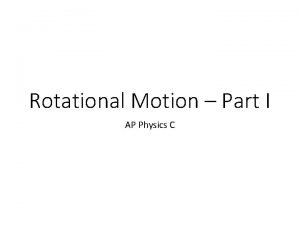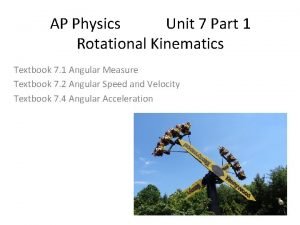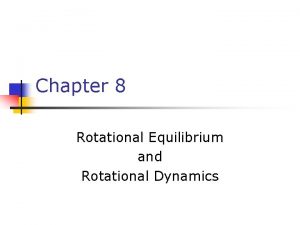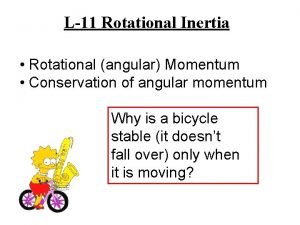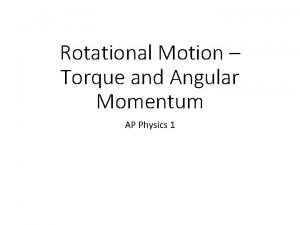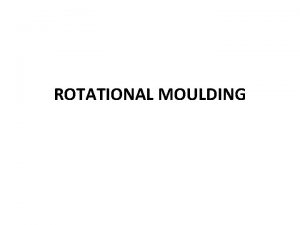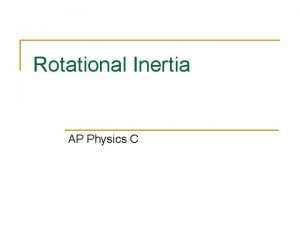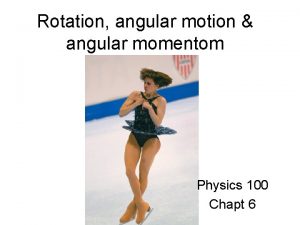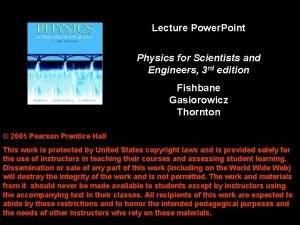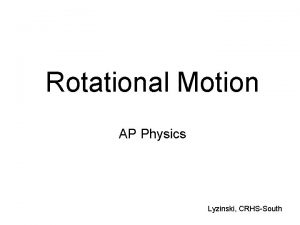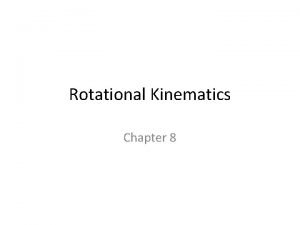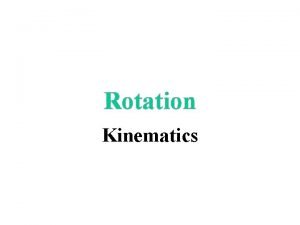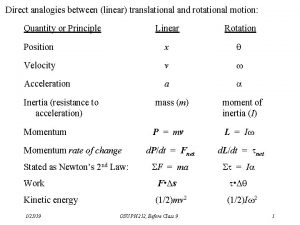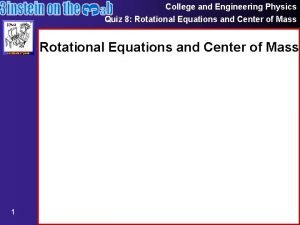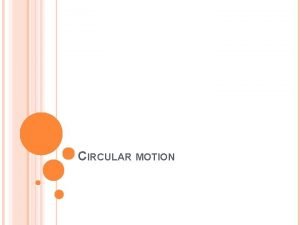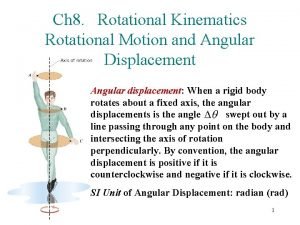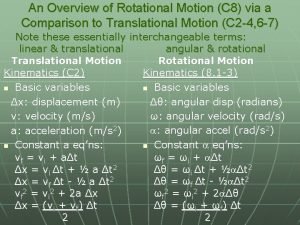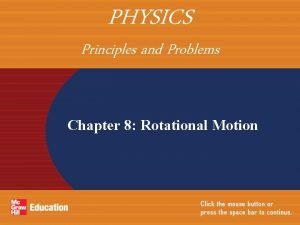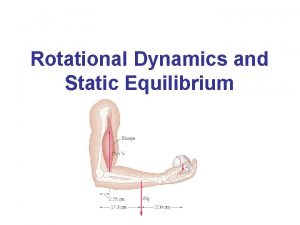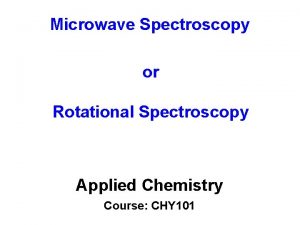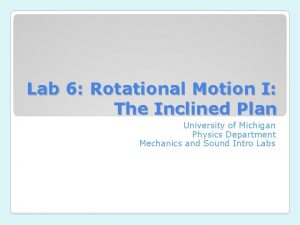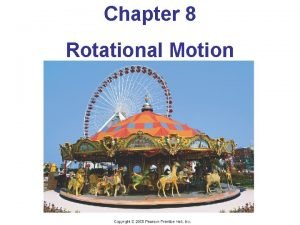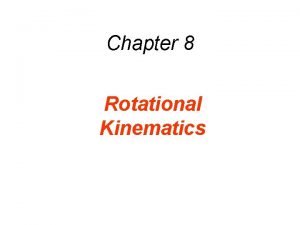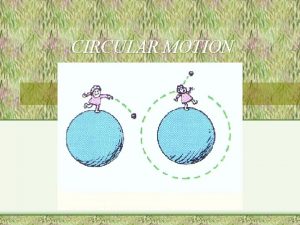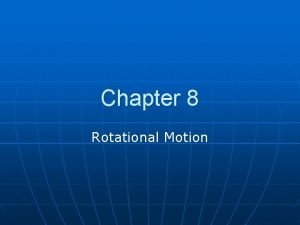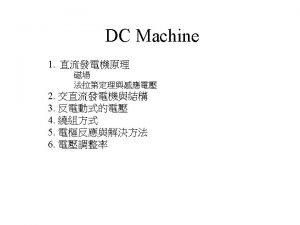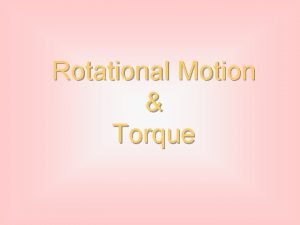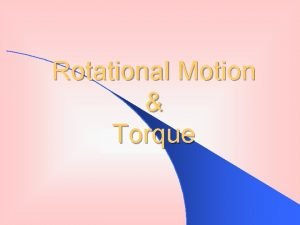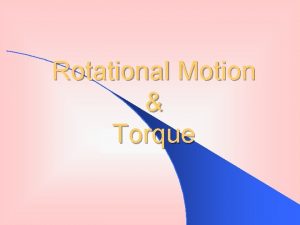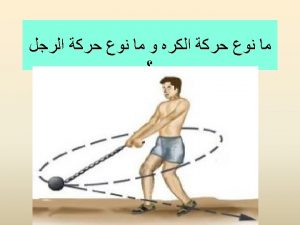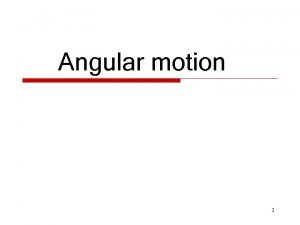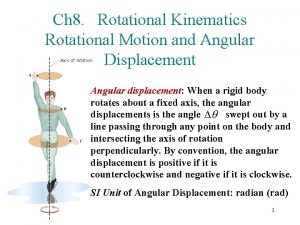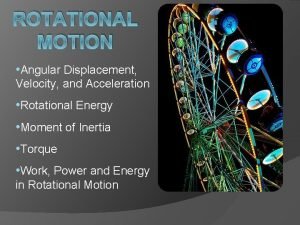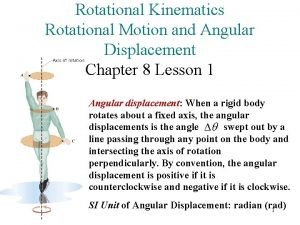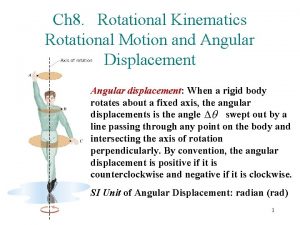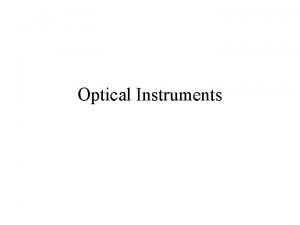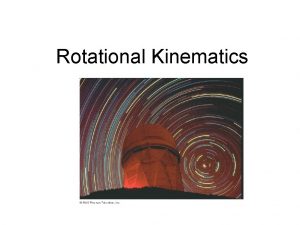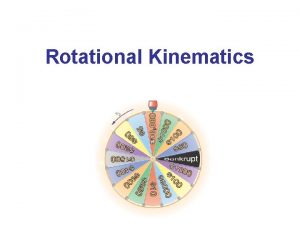ROTATIONAL MOTION AP Physics End Slide ANGULAR MOTION





























- Slides: 29

ROTATIONAL MOTION AP Physics

End Slide ANGULAR MOTION

End Slide ANGULAR MOTION

End Slide LINEAR VS. ANGULAR MOTION Linear Motion • . Angular Motion • .

End Slide LINEAR VS. ANGULAR MOTION Linear Motion • . Angular Motion • .

End Slide ROTATING PAPER • The speed of. DISKS a moving bullet can be determined by allowing the bullet to pass through two rotating paper disks mounted a distance 96 cm apart on the same axle. From the angular displacement 24. 2 o of the two bullet holes in the disks and the rotational speed 471 rev/min of the disks, what is the speed of the bullet?

End Slide ANGULAR SPEED OF A RECORD • A record player has a frequency of 26 rev/min. • What is its angular speed? • Through what angle does it rotate in 1. 13 s?

End Slide ROTATING POTTER’S WHEEL • A potter’s wheel of radius 14 cm starts from rest and rotates with constant angular acceleration until at the end of 25 s it is moving with angular velocity of 15 rad/s. • What is its angular acceleration? • What is the linear velocity of a point on the rim at the end of the 25 s?

End Slide ROTATING POTTER’S WHEEL • A potter’s wheel of radius 14 cm starts from rest and rotates with constant angular acceleration until at the end of 25 s it is moving with angular velocity of 15 rad/s. • Through what angle did the wheel rotate in the 25 s? • What is the average angular velocity of the wheel during the 25 s?

End Slide SPIN CYCLE • In the spin cycle of a washing machine, the tub of radius 0. 499 m develops a speed of 659 rpm. What is the maximum linear speed with which water leaves the machine? ?

End Slide MERRY GO ROUND • Jason and Isaac are riding on a merry-go-round. Jason rides on a horse at the outer rim of the circular platform, twice as far from the center of the circular platform as Isaac, who rides on an inner horse. When the merry-goround is rotating at a constant angular speed, what is Jason’s angular speed relative to Isaac’s? • The angular speed is the same as Isaac’s • Their translational velocities will be different because of the difference in radius. • Jason will have twice the translational velocity. Nothing to do with radius Includes radius

End Slide SPACE STATION DESIGN • You want to design a large, permanent space station so that no artificial gravity is necessary. You decide to shape it like a large coffee can of radius 198 m and rotate it about its central axis. • What rotational speed would be required to simulate gravity? • If an astronaut jogged in the direction of the rotation at 4. 7 m/s, what simulated gravitational acceleration would the astronaut feel?

End Slide TURTLE NAMED DIZZY • A small turtle, appropriately named “Dizzy”, is placed on a horizontal, rotating turntable at a distance of 15 cm from its center. Dizzy’s mass is 50 g, and the coefficient of static friction between his feet and turntable is 0. 2. • Find the maximum number of radians per second the turntable can have if Dizzy is to remain stationary relative to the turntable. • What’s the frequency?

End Slide TURTLE NAMED DIZZY • A small turtle, appropriately named “Dizzy”, is placed on a horizontal, rotating turntable at a distance of 15 cm from its center. Dizzy’s mass is 50 g, and the coefficient of static friction between his feet and turntable is 0. 2. • The turntable starts from rest at t = 0, and has a uniform acceleration of 1. 8 rad/s 2. Find the time at which Dizzy begins to slip.

End Slide NEWTON’S 2 ND LAW FOR ROTATION

End Slide ROTATIONAL INERTIA • Different objects have their masses distributed differently. • This distribution of mass will cause one object’s rotation to be harder to change than another.

End Slide ROTATIONAL INERTIA

End Slide NEWTON’S 2 ND LAW FOR ROTATION

End Slide EXAMPLES OF ROTATIONAL INERTIA For a single particle For a solid sphere For a hollow sphere Axis of Rotation

End Slide EXAMPLES OF ROTATIONAL INERTIA Axis of Rotation For a rod from center Axis of Rotation For a rod from end For a disk or cylinder (central axis) Axis of Rotation

End Slide EXAMPLES OF ROTATIONAL INERTIA Axis of Rotation For a thin hoop (central axis) For a thin hoop (diameter) Axis of Rotation

RIM OF A BICYCLE • A 1. 28 kg bicycle wheel, which can be thought of as a thin hoop, has a radius of 42 cm. The gear attached to the central axis of the wheel has a radius of 6. 8 cm and a chain is pulling on the gear with a constant force of 300 N. • What is the angular acceleration of the wheel? • Starting from rest, what is the angular velocity of the wheel after 1. 80 sec? End Slide

RIM OF A MERRY GO ROUND End Slide • A 150 kg merry-go-round in the shape of a horizontal disk of radius 1. 5 m is set in motion by wrapping a rope about the rim of the disk and pulling on the rope. What constant force would have to be exerted on the rope to bring the merry-go-round from rest to an angular speed of 0. 5 rev/s in 2 s?

PIVOTING ROD • A long uniform rod of length 1. 11 m and End Slide mass 4. 37 kg is pivoted about a horizontal, frictionless pin through one end. The rod is released from rest in a vertical position as in the figure. • At the instant the rod is horizontal, find the magnitude of its angular acceleration. • At the same instant, find the magnitude of the acceleration of its center of mass.

PIVOTING ROD • A long uniform rod of length 1. 11 m and End Slide mass 4. 37 kg is pivoted about a horizontal, frictionless pin through one end. The rod is released from rest in a vertical position as in the figure. • At the same instant, find the force exerted on the end of the rod by the axis. Pivot

End Slide ATWOOD MACHINE • An Atwood machine is constructed using a disk of mass 2. 1 kg and radius 24. 9 cm. The mass hanging on one side of the pulley is 1. 61 kg and the mass on the other side is 1. 38 kg. The pulley is free to rotate and the string connecting the masses does not slip. • What is the acceleration of the system? Free Body Diagrams

End Slide ATWOOD MACHINE

End Slide ROLLING DOWN THE RAMP • Two masses roll down an incline. One is a “hoop” and the other is a solid disk. Each have about the same mass (0. 467 kg) and radius (0. 076 m). Both will be released to roll 140 cm down an 8. 0 o incline. • Which will get to the bottom first? • What will be the difference in time between the two?

End Slide ROLLING DOWN THE RAMP • Two masses roll down an incline. One is a “hoop” and the other is a solid disk. Each have about the same mass (0. 467 kg) and radius (0. 076 m). Both will be released to roll 140 cm down an 8. 0 o incline. • Which will get to the bottom first? • What will be the difference in time between the two?
 Ap physics rotational motion
Ap physics rotational motion Ap physics c rotational motion
Ap physics c rotational motion Ap physics unit 7
Ap physics unit 7 Chapter 11 rotational equilibrium
Chapter 11 rotational equilibrium Second condition of equilibrium
Second condition of equilibrium Heel and toe polka dance
Heel and toe polka dance Rotational inertia symbol
Rotational inertia symbol Angular momentum theorem
Angular momentum theorem Strengh
Strengh Rotational molding advantages and disadvantages
Rotational molding advantages and disadvantages Parallel axis theorem ap physics c
Parallel axis theorem ap physics c Angular quantities
Angular quantities Torque direction rule
Torque direction rule Rotational motion equations
Rotational motion equations Rotational motion and the law of gravity
Rotational motion and the law of gravity 4 linear motion equations
4 linear motion equations Angular motion equations
Angular motion equations Analogy between linear and rotational motion
Analogy between linear and rotational motion Torque and rotational motion quiz
Torque and rotational motion quiz Circular motion formulas
Circular motion formulas Symbol for angular displacement
Symbol for angular displacement Translational vs rotational motion
Translational vs rotational motion What is rotational flow
What is rotational flow Chapter 8 rotational motion answer key
Chapter 8 rotational motion answer key Static equilibrium rotational motion
Static equilibrium rotational motion Rotational spectroscopy
Rotational spectroscopy Rotational dynamics lab
Rotational dynamics lab Rotational motion
Rotational motion Rotational motion
Rotational motion Rotational motion
Rotational motion
